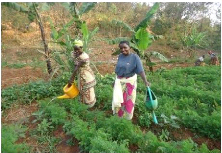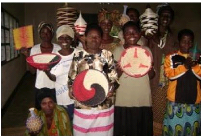Among challenges facing microfinance industry in developing
nations are:
? High cost of service delivery with poor infrastructure,
regulatory policy issues and the need to develop institutional leadership.
Because infrastructure and communication technology remain largely
underdeveloped in most developing nations, it is significantly more expensive
for microfinance institutions in these nations to operate compared to their
peers in developed countries.
? Another challenge is policy making and government
regulations, which vary by country. I many countries, the supervisory capacity
of central banks, which holds the ultimate responsibility of financial sector
needs an adjustment. The countries which are able to close the microfinance
demand gap most successfully will be those that improve their policy frameworks
and adapt their legal and regulatory systems in line with rapidly changing
environment.
? A low population density area where the number of women to
form a variable group is inadequate also poses as challenges. The situation is
worsened by the unequal distribution of the family resources, which makes it
difficult for women to raise the necessary savings and participate in a
group.
? Some women access credit, but only to pass it into others
who are not directly accountable, leaving them with the loan repayment burden.
The one year repayment period is one of the reasons for default in repayments.
Examples of such failure make other women reluctant to borrow. Another one is
because of the society's perception of a
22
women's place in the home, some women are reluctantly not
informed of the existence of sources of finance.
Micro-finance programs have a significant potential
contribution to women's economic, social and political empowerment. Access to
savings and credit can initiate or strengthen a series of interlinked and
mutually reinforcing ' virtuous spirals ' of empowerment (See Figure 2).
· Women can use savings and credit for economic
activity, thus increasing incomes and assets and control over these incomes and
assets.
· This economic contribution may increase their role in
economic decision-making in the household leading to greater well-being for
women, children as well as men.
· Their increased economic role may lead to change in
gender roles and increased status within households and communities.

The women in agriculture sector
These virtuous spirals are potentially mutually reinforcing in
that both improved well-being and change in women's position may further
increase their ability to increase incomes and so on.
This process of empowerment may be further reinforced by group
formation focusing on savings and credit delivery:
· Women can access wider information and support networks
for economic activity.
· Groups can support women in disputes within the household
and community
· Groups can link to wider movements for change in women's
position.
23
Particularly in Rwanda microfinance programs like those of PTH
through of Duterimbere, Inkingi, Agaseke, Goshen, etc have been pioneers of an
empowerment approach to development for women in the informal sector and rural
areas.
However although it is clear that microfinance programs have
led to such changes for some women in microfinance programs, these changes are
not an automatic consequence of savings and credit alone or of group formation.
Evidence suggests that even in financially successful micro finance
programs:
· Most women remain confined to a narrow range of ' female
' low-income activities
· Many women have limited control over income and/or
what little income they earn may substitute for former male household
contributions as men retain more of their earnings for their own use
· Women often have greater workloads combining both
production and reproductive tasks
· Women's expenditure decisions may continue to
prioritize men and male children while daughters or daughters in law bear the
brunt of unpaid domestic work
· Where women actively press for change this may
increase tensions in the household and domestic violence
· Women remain marginalized in local and national level
political processes

Together association of women supported by Dutermbere
Microfinance through microcredit.
24
This is not just a question of lack of impact, but may also be a
process of disempowerment:
? Credit is also debt. Savings and loan interest or insurance
payments divert resources which might otherwise go for necessary consumption or
investment.
? Putting the responsibility for savings and credit on women
may absolve men of responsibility for the household.
? Where group meetings focus only on savings and credit this
uses up women's precious
work and leisure time, cutting program costs but not necessarily
benefiting women.
Impacts are therefore very complex. There may be trade-offs
for individual women which they negotiate to the best of their ability. There
may be both reinforcing and conflicting changes at household level. Impacts on
gender inequalities at the community level may also combine elements of
empowerment and disempowerment and affect different women in different ways.

Handcraft trading for AGASEKE Association, there are used the
loans microfinance in their activities.
Importantly women themselves are not passive victims, but
active participants using opportunities as best they can in the context of the
many constraints of gender inequality and poverty. Many apparent positive
impacts may be more due to the determination and ingenuity of women than to
program policy. Many negative impacts may be unavoidable because of the
magnitude of constraints.
25
26
Fig.1 VIRTUOUS SPIRALS :
QUESTIONING ASSUMPTIONS



